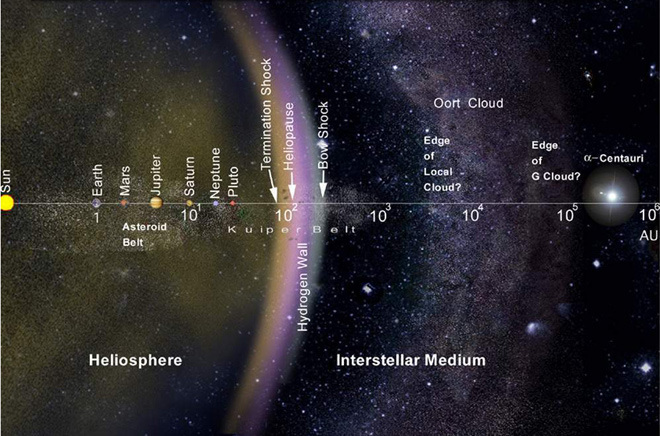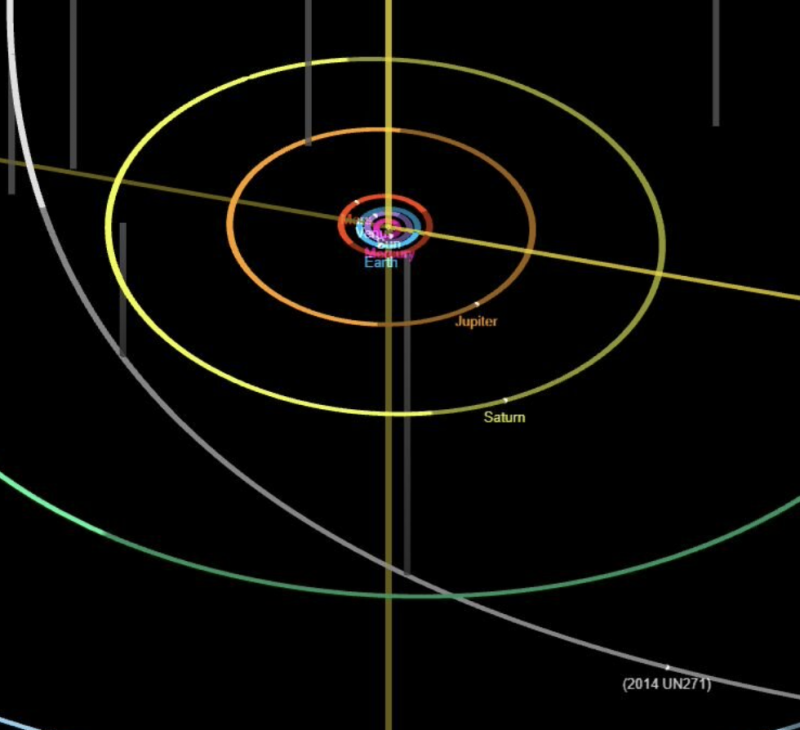Oxford Dictionary of Astronomy Ian Ridpath Oxford University Press 2011
"A roughly spherical halo of comet nuclei surrounding the Sun, out to perhaps 100,000 AU (over one third of the distance to the nearest star). Its existence was proposed in 1950 by J H Oort to account for the fact that new comets approach the Sun on highly elliptical orbits at all inclinations."
"The Oort Cloud remains a theoretical concept, since we cannot currently detect comets at such great distances. The cloud is estimated to contain 10^12 comets remaining from the formation of the Solar System. The most distant members are fairly loosely bound by the Sun's gravity. There may be a greater concentration of comets relatively close to the ecliptic, at 10,000 to 20,000 AU from the Sun, extending inwards to join the Kuiper Belt. Oort Cloud comets are affected by the gravitational influence of passing stars, occasionally being perturbed into orbits which take them through the inner Solar System."
View: https://imgur.com/a/1DJboMw
Don't forget comets do not develop a tail until near the Sun, so are otherwise not easily visible, especially at great distances. Comet Tempel 1 NASA.
Complete History of the Universe All About Space 2016
"Oort Cloud
An enormous region of space encapsulating the planets and stretching 50,000 AU from the Sun to around 100,000 AU in diameter at its outer boundaries: from one side to the other its about 2 light years long."
"It's made of water, ammonia and methane ice, in the form of icy particles and trillions of larger bodies. It's suspected that many of the Solar System's comets were born here, and some trans-Neptunian objects are Oort Cloud members too. It's divided into two distinct regions, the inner and outer Oort Cloud containing several trillion comets larger than 1 km (0.62 mile) in diameter. [These must be estimates, since they cannot be seen at this distance] Considering the size of the Oort Cloud, it would take our fastest spacecraft launch, New Horizons, around 20,000 years to reach its outer edge at 58,536 km/hour (36.373 miles/hour. The Oort Cloud isn't very massive, just a fraction pf the 100 or so Earth masses of material ejected from the centre of the Solar System."
Collins Discovery Guide - Universe Pam Spence William Collins 2018
"The most spectacular objects in the Solar System are the comets, which can produce awe inspiring tails millions of km long. Cometary orbits are not confined to the plane of the Solar System, where the planets and asteroids are found, but can approach the Sun from any angle. This fact, together with the numbers of new comets observed each year, suggests that there is a reservoir of cometary material surrounding the Solar System. This reservoir is called the Oort Cloud which is believed to extend from around 30,000 to 100,000 AU."
"The Oort Cloud has never actually been observed - its existence was suggested by the Dutch astronomer J H Oort to explain the trajectories and number of long period comets (comets that take 200 years or more to orbit the Sun) that are seen. However, comets have been seen coming directly from that far out and it is the logical explanation for their origin.

 phys.org
phys.org
View: https://imgur.com/a/neeV7vm
"The Oort Cloud is a theoretical spherical cloud of predominantly icy planetesimals that is believed to surround the sun at a distance of up to around 100,000 AU (2 ly). This places it in interstellar space, beyond the sun's Heliosphere where it defines the cosmological boundary between the solar system and the region of the sun's gravitational dominance."
So one suggestion is that the Oort Cloud is a hypothetical subdivision of interstellar space; nonetheless, inhabited by large numbers of comets - which can be diverted towards the inner Solar System - and possibly other objects.
The dust and (frozen) water are natural inhabitants of such an environment.
WORK IN PROGRESS last edit Monday 12th July 18.20 BST.
"A roughly spherical halo of comet nuclei surrounding the Sun, out to perhaps 100,000 AU (over one third of the distance to the nearest star). Its existence was proposed in 1950 by J H Oort to account for the fact that new comets approach the Sun on highly elliptical orbits at all inclinations."
"The Oort Cloud remains a theoretical concept, since we cannot currently detect comets at such great distances. The cloud is estimated to contain 10^12 comets remaining from the formation of the Solar System. The most distant members are fairly loosely bound by the Sun's gravity. There may be a greater concentration of comets relatively close to the ecliptic, at 10,000 to 20,000 AU from the Sun, extending inwards to join the Kuiper Belt. Oort Cloud comets are affected by the gravitational influence of passing stars, occasionally being perturbed into orbits which take them through the inner Solar System."
View: https://imgur.com/a/1DJboMw
Don't forget comets do not develop a tail until near the Sun, so are otherwise not easily visible, especially at great distances. Comet Tempel 1 NASA.
Complete History of the Universe All About Space 2016
"Oort Cloud
An enormous region of space encapsulating the planets and stretching 50,000 AU from the Sun to around 100,000 AU in diameter at its outer boundaries: from one side to the other its about 2 light years long."
"It's made of water, ammonia and methane ice, in the form of icy particles and trillions of larger bodies. It's suspected that many of the Solar System's comets were born here, and some trans-Neptunian objects are Oort Cloud members too. It's divided into two distinct regions, the inner and outer Oort Cloud containing several trillion comets larger than 1 km (0.62 mile) in diameter. [These must be estimates, since they cannot be seen at this distance] Considering the size of the Oort Cloud, it would take our fastest spacecraft launch, New Horizons, around 20,000 years to reach its outer edge at 58,536 km/hour (36.373 miles/hour. The Oort Cloud isn't very massive, just a fraction pf the 100 or so Earth masses of material ejected from the centre of the Solar System."
Collins Discovery Guide - Universe Pam Spence William Collins 2018
"The most spectacular objects in the Solar System are the comets, which can produce awe inspiring tails millions of km long. Cometary orbits are not confined to the plane of the Solar System, where the planets and asteroids are found, but can approach the Sun from any angle. This fact, together with the numbers of new comets observed each year, suggests that there is a reservoir of cometary material surrounding the Solar System. This reservoir is called the Oort Cloud which is believed to extend from around 30,000 to 100,000 AU."
"The Oort Cloud has never actually been observed - its existence was suggested by the Dutch astronomer J H Oort to explain the trajectories and number of long period comets (comets that take 200 years or more to orbit the Sun) that are seen. However, comets have been seen coming directly from that far out and it is the logical explanation for their origin.

What is the Oort Cloud?
For thousands of years, astronomers have watched comets travel close to Earth and light up the night sky. In time, these observations led to a number of paradoxes. For instance, where were these comets all coming from? And if their surface material vaporizes as they approach the sun (thus...
View: https://imgur.com/a/neeV7vm
"The Oort Cloud is a theoretical spherical cloud of predominantly icy planetesimals that is believed to surround the sun at a distance of up to around 100,000 AU (2 ly). This places it in interstellar space, beyond the sun's Heliosphere where it defines the cosmological boundary between the solar system and the region of the sun's gravitational dominance."
So one suggestion is that the Oort Cloud is a hypothetical subdivision of interstellar space; nonetheless, inhabited by large numbers of comets - which can be diverted towards the inner Solar System - and possibly other objects.
The dust and (frozen) water are natural inhabitants of such an environment.
WORK IN PROGRESS last edit Monday 12th July 18.20 BST.
Last edited:



